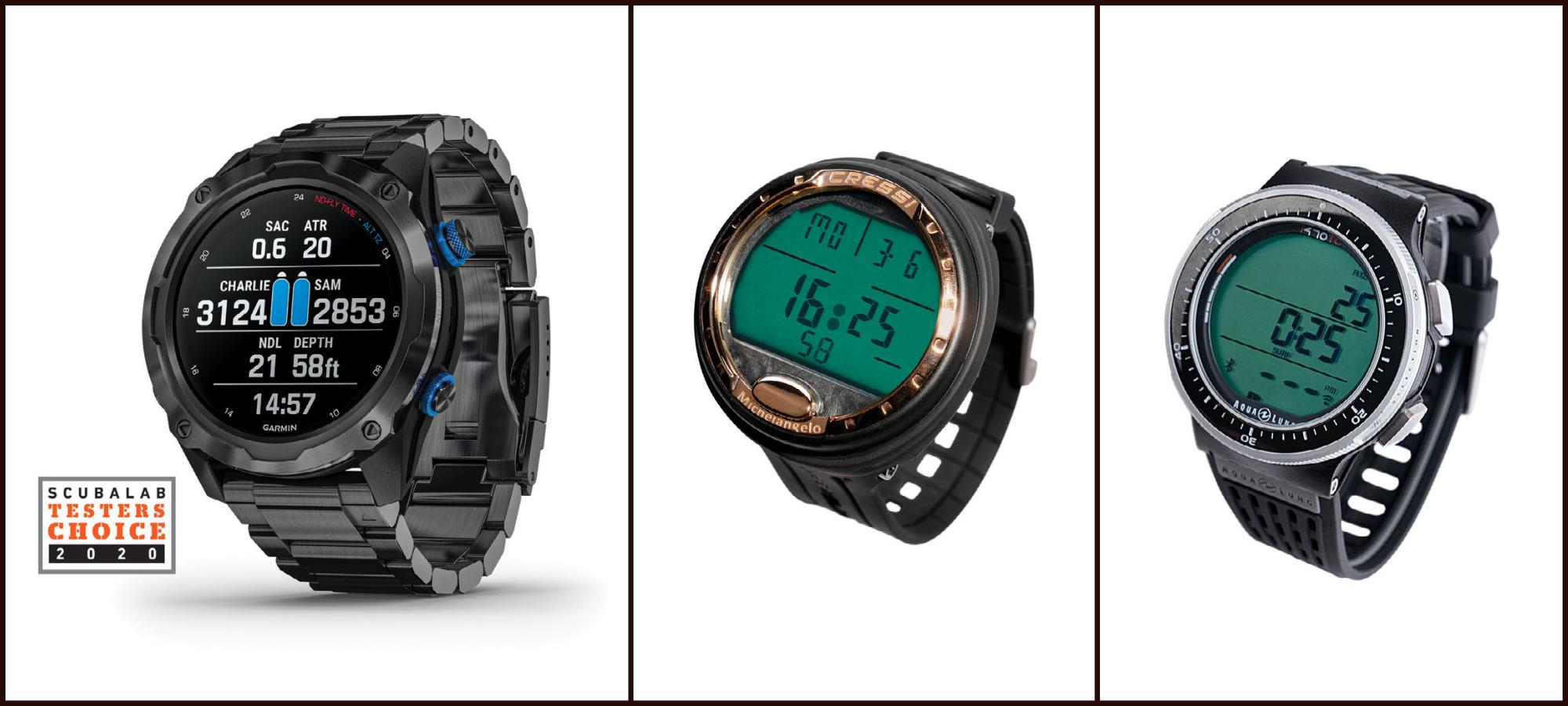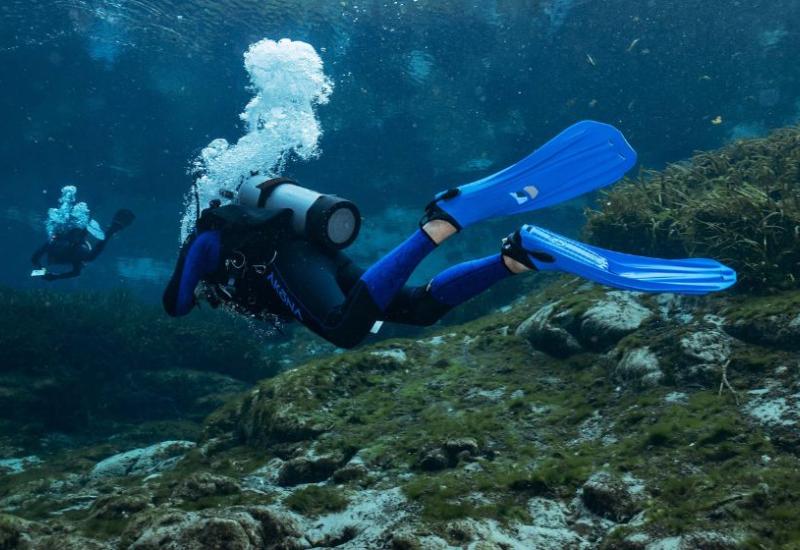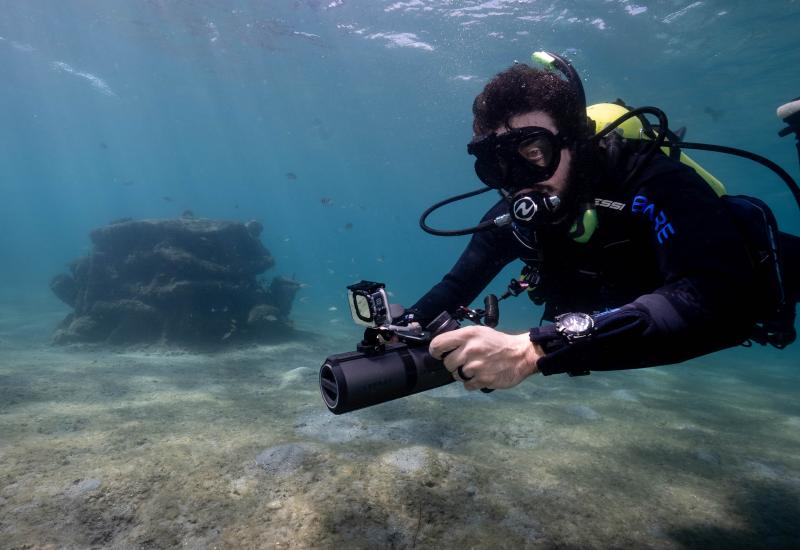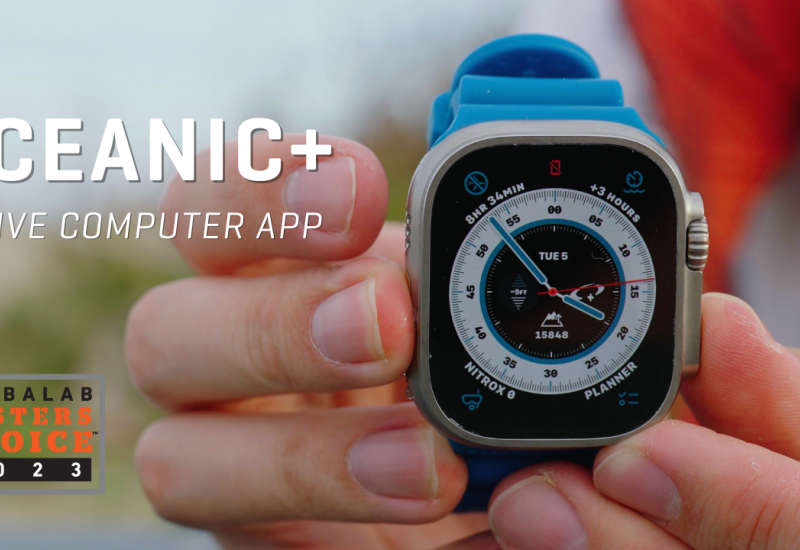The Best Dive Computers of 2020
HOW WE TEST
Our test evaluated two aspects of a computer’s performance: how easy it is to operate and understand before, during and after a dive, and an objective measure of its decompression algorithm relative to other computers in the test.
HOW WE SCORE
The top graph shows the score for intuitiveness of operation and the bottom graph shows the combined score for readability— surface and underwater—and data display, with scoring of:
5=excellent
4=very good
3=good
2=fair
1=poor
TEST DIVE PROTOCOL
Test divers evaluated computers in nine categories. Test dives were conducted at Blue Grotto Dive Resort in Williston, Florida, where divers recorded their scores in written comments about their experiences using each computer. Test categories were:
■ Intuitiveness and ease of operation, including configuring settings
■ General ergonomics, such as size and shape; comfort; and effectiveness of buttons, straps
■ Ease of reading screen at the surface, including in sun
■ Ease of reading screen underwater, including performance of backlight
■ Overall quality of dive data display, including selection, layout and presentation of data, with a focus on how clearly it presents critical dive information
■ Usefulness and ease of accessing alternate dive screen data
■ Safety stop performance, including alerts and timer
■ Ease of accessing and usefulness of surface interval data, including no-fly time
■ On-board log data, including ease of access
ScubaLab staff also tested computers in a benchtop compression chamber to observe screen displays, warnings and alarms in conditions not suitable for testing by divers, such as rapid ascents and missed deco stops. The goal of these tests is to gauge how well each computer performed in providing a diver with clear, understandable guidance in those conditions.
OBJECTIVE TEST PROTOCOL
To gauge the relative conservatism or liberalism of the computers’ algorithms, they were subjected together to a series of four dive simulations in the University of Southern California Catalina Hyperbaric Chamber. Meant to simulate a day of diving, the multistage profiles were: 100 feet/55 minutes; a one-hour surface interval; 70 feet/45 minutes; a two-hour surface interval; 80 feet/45 minutes; a one-hour surface interval; and 60 feet/40 minutes.
To see full chamber-test NDL readings for each computer, click here. Special thanks to Catalina Hyperbaric Chamber director Karl E. Huggins and operators Tom Carr and Andy Klesh.
Watch-Style Computers
Garmin Descent Mk2i
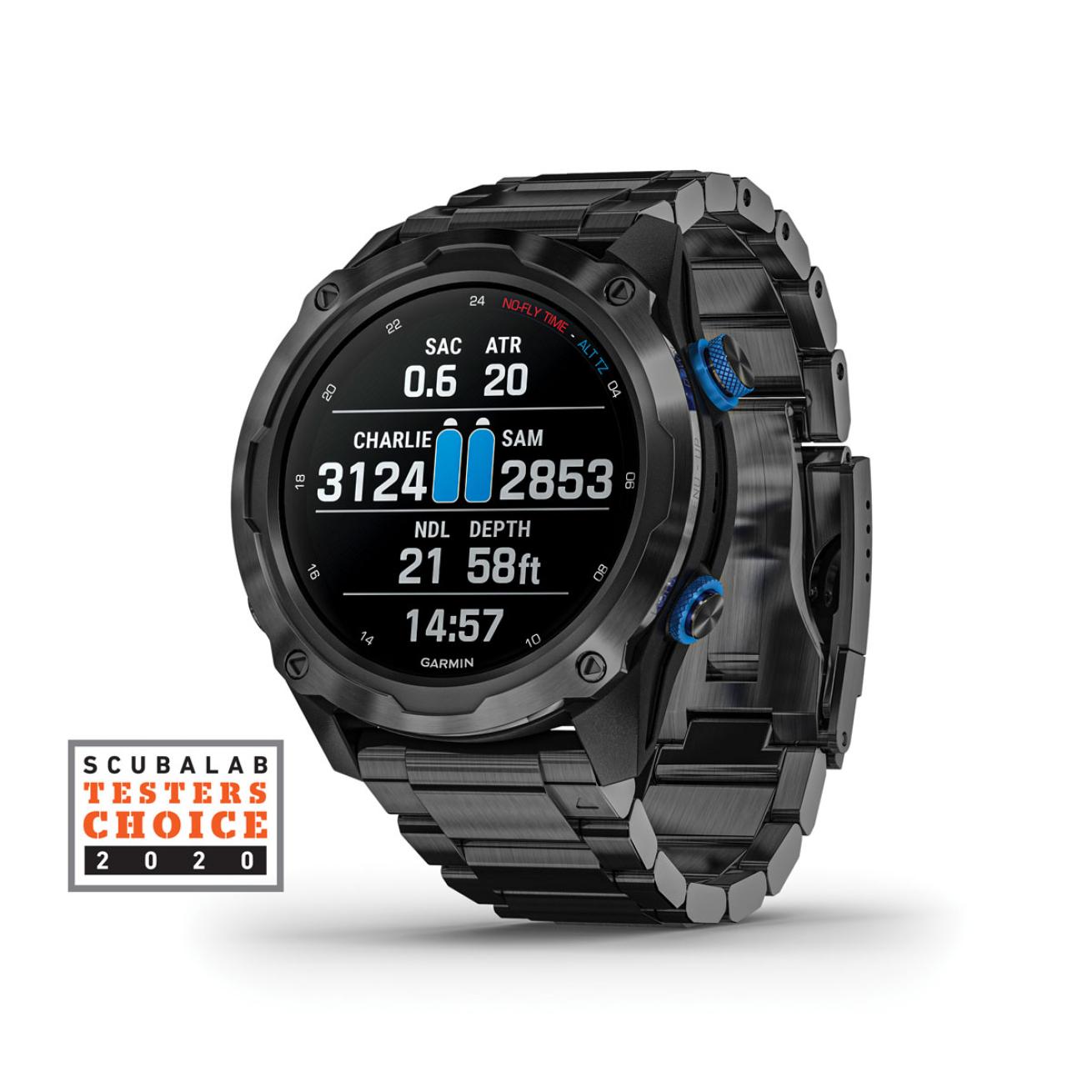
Jon WhittlePRICE $1,499.99, transmitter $399.99 | CONTACT garmin.com
The air-integrated MK2i was so new when we received our test sample that its full manual wasn’t yet available, but it’s so easy to set, navigate and operate that turned out to be no problem. In fact, no computer scored higher for easy and intuitive operation, which is saying something because the MK2i is packed with features: heart rate monitor, GPS, mapping and a long list of fitness and adventure activities (stand-up paddleboarding, yoga, skydiving).
“Tons to explore here,” noted one tester. Most important, despite all the other goodies, the MK2i is a dive computer first and foremost. The 1.4-inch-wide color display is crisp, well-organized and highly visible in all conditions; testers rated it excellent for readability underwater. Alternate dive screens offer extensive data; you can scroll through by button or with a double tap of the screen. Visuals like the ascent/descent graph are clear and easy to understand; critical data are accompanied with both audible and vibrating alerts.
The MK2i can view the tank pressure and battery status of up to four other divers, and it can be paired with Garmin’s divable inReach Mini satellite communicator to receive text alerts and send an SOS on the surface. Refi ned, highly capable, yet remarkably easy to use, the MK2i is our Testers Choice for dive computers.
| DOWNLOAD | Bluetooth or USB cable |
| BATTERY | Sealed rechargeable lithium |
| ALGORITHM | We set it for liberal no-deco times, but you can select preset gradient factors or customize your own. |
Aqua Lung i470TC
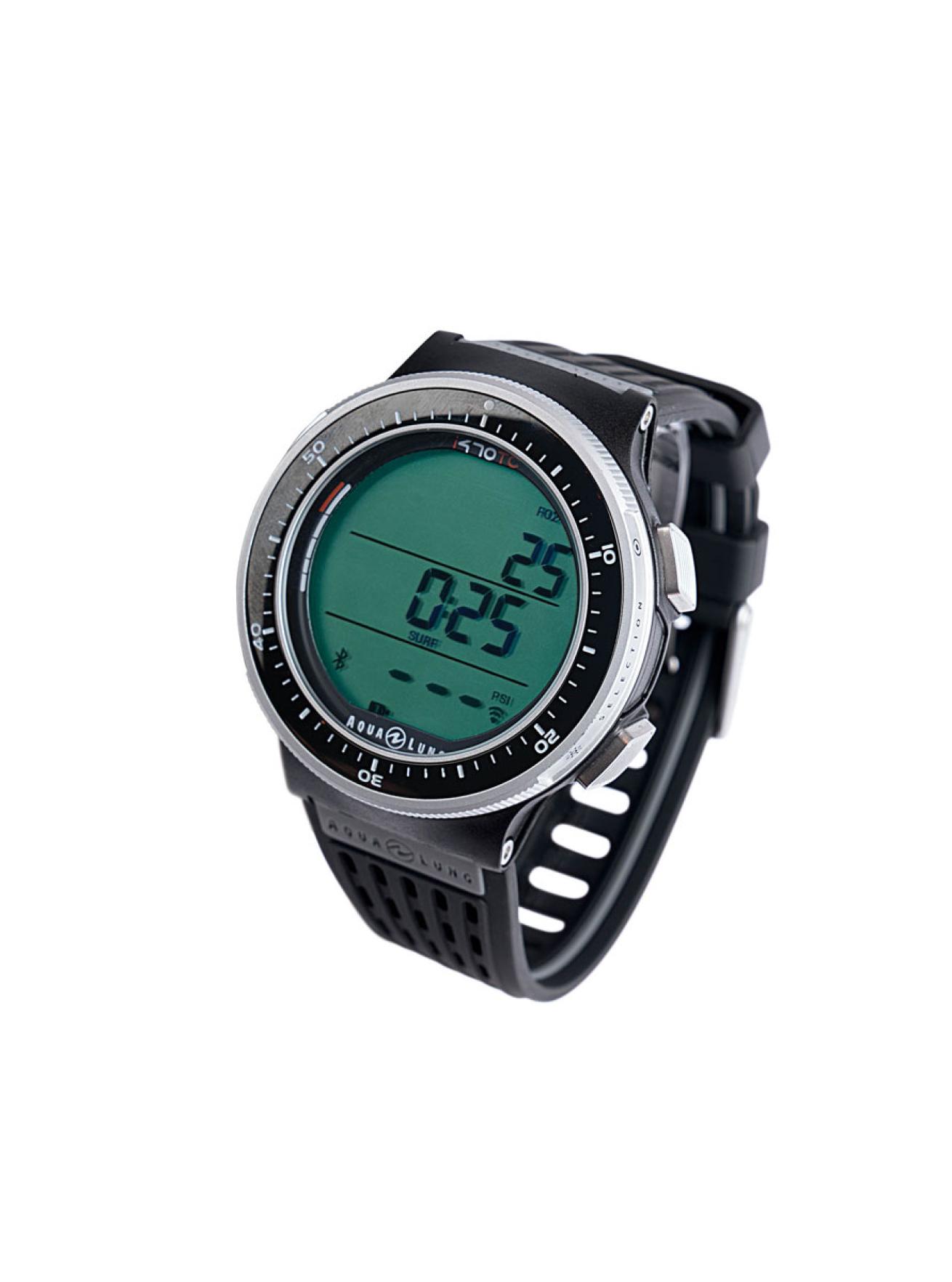
Jon WhittlePRICE $499 | CONTACT aqualung.com
The i470TC won praise even before we got it in the water from test divers who liked its look and feel, with its knurled, graduated bezel and a compact, satisfying heft very much like a nicely made dive watch. But it has full dive chops as well, with wireless air integration and three-transmitter compatibility. A 1¼- inch display allows it to present tank pressure and other data in bold, high-contrast characters that earned it very good scores for readability underwater and at the surface. Test divers praised it for its “clean and undiluted” data presentation, which tied the top score for quality of dive info display. It also tied the top score for overall ergonomics, thanks to its unobtrusive dimensions and precise, comfortable four-button control. Rated good for intuitiveness of operation, menus are well marked and logical—“no mysteries, no surprises,” one diver noted—and are simplified by the lack of complications such as a digital compass. With wireless air integration in a refined, watch-size package at an attractive price, the i470TC was among the favorites of test divers and a top contender in our test.
| DOWNLOAD | Bluetooth |
| BATTERY | User-replaceable |
| ALGORITHM | NDLs were slightly conservative in our chamber dives. |
Cressi Michelangelo
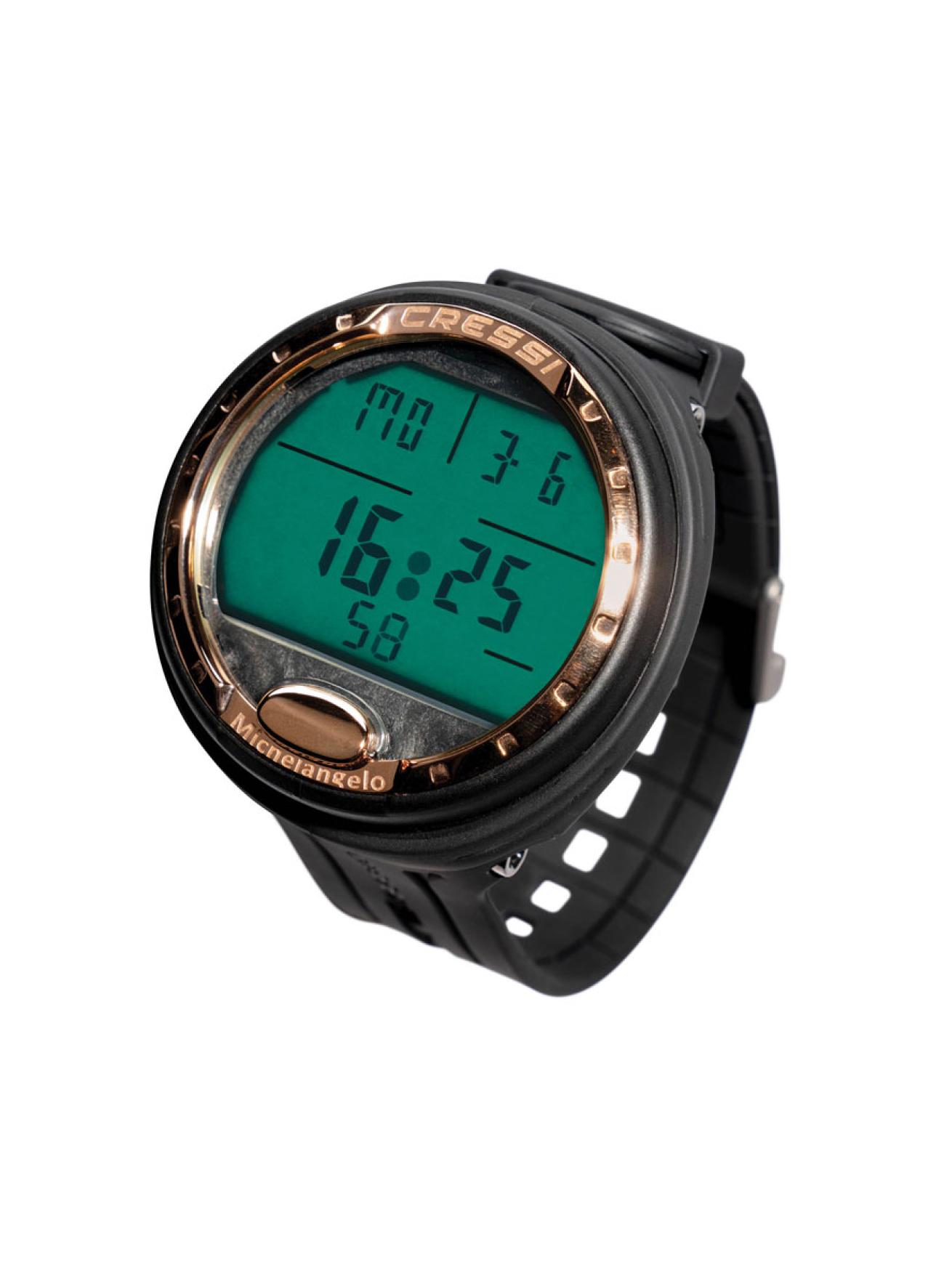
Jon WhittlePRICE $349.95 | CONTACT cressi.com
The Michelangelo’s most obvious design features—single-button operation and a display nearly 2 inches across—suggest it’s a simple computer that’s easy to read. So it proved, taking very good scores for its intuitive operation and its readability underwater. The operation uses long and short presses to toggle and select settings, with highlighted options blinking to guide the process. While it can take a bit of pressing for some selections (especially nitrox), it’s so easy to learn the routine that even the newest diver can pick it up in minutes. “Super simple to operate,” one tester noted. The high-contrast display, with an effective backlight and characters that are almost a half-inch tall, make it highly visible, while the segmented screen has a clean if basic layout. The screen’s dimensions make the Michelangelo chunky enough that divers with smaller wrists found it an armful, though it was rated good overall for ergonomics. There’s no digital compass, and alternate dive screen data is limited, but the Michelangelo is worth a look for newer divers in search of an unintimidating computer that’s easy to read and understand.
| DOWNLOAD | Optional interface cable |
| BATTERY | User-replaceable |
| ALGORITHM | NDLs were slightly conservative in our chamber dives. |
Genesis Centauri
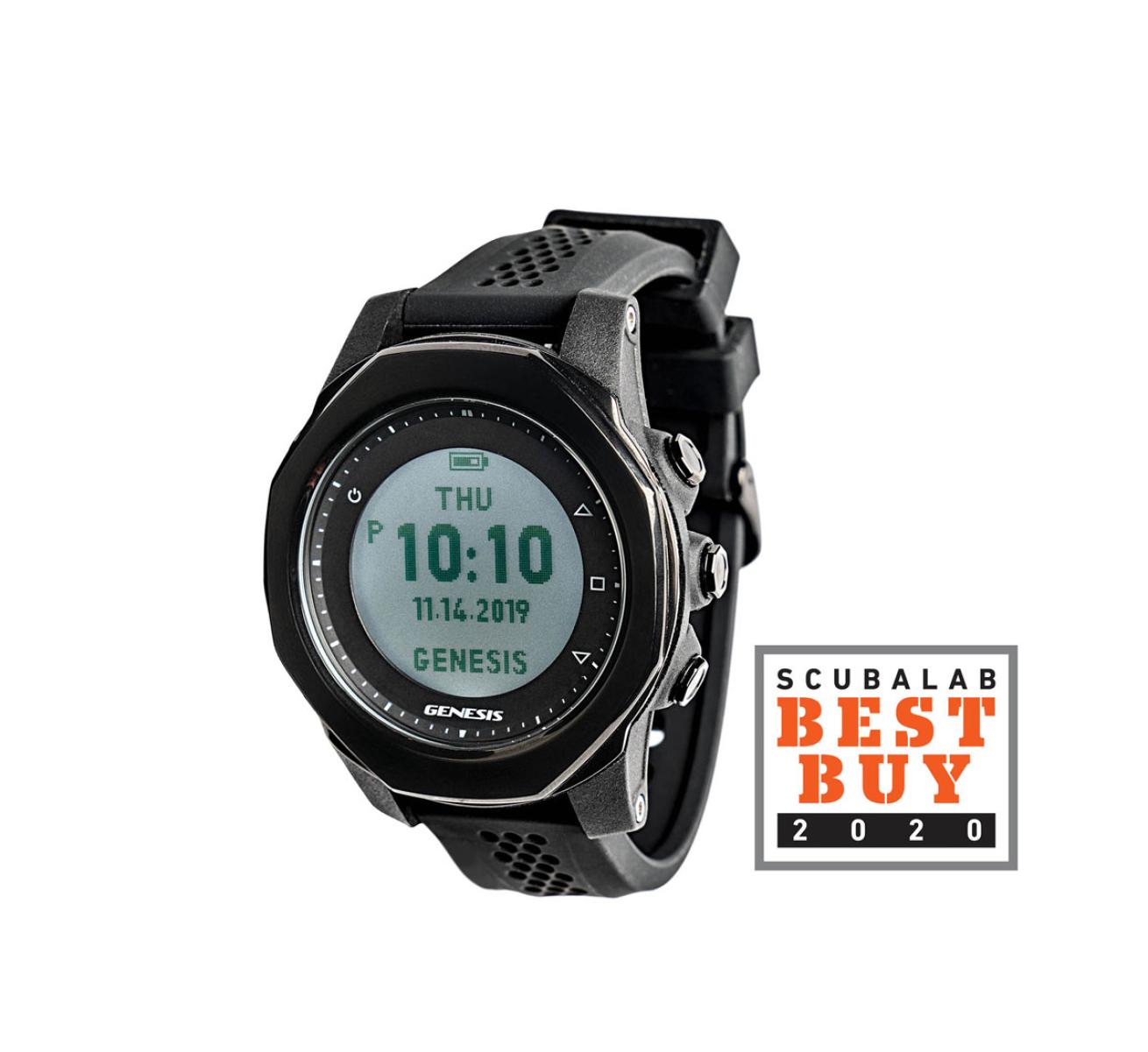
Jon WhittlePRICE $345 | CONTACT genesisscuba.com
The watch-size Centauri’s screen is just 1.1 inches in diameter, but easy to read thanks to its segmented, clearly marked display and glowing illumination, which stays on during a dive and has five power levels. Test divers rated it very good for readability at depth and on the surface (although bright sun did tend to wash it out). Testers also liked the menu navigation, which identifies the function at play and shows its current setting. That helps even a new diver keep track of where they are in the menus, which are long but logically organized. Part of the reason for the long menus is the Centauri offers a fair amount of adjustment, including a choice of standard six-field dive display or a simplified three-field view. The attention-getting vibration function works nicely with the computer’s crystal-clear deco and safety-stop displays, which have a prominent timer and “CLEAR” alert when completed. “Excellent safety stop,” noted one tester, and others agreed, giving it the top score in the test. Capable and easy to use, attractively priced and selected among the favorites of test divers, the Centauri is our Best Buy.
| DOWNLOAD | Bluetooth or USB cable |
| BATTERY | Sealed rechargeable lithium |
| ALGORITHM | NDLs were just slightly conservative in our chamber dives. |
Scubapro Aladin A1
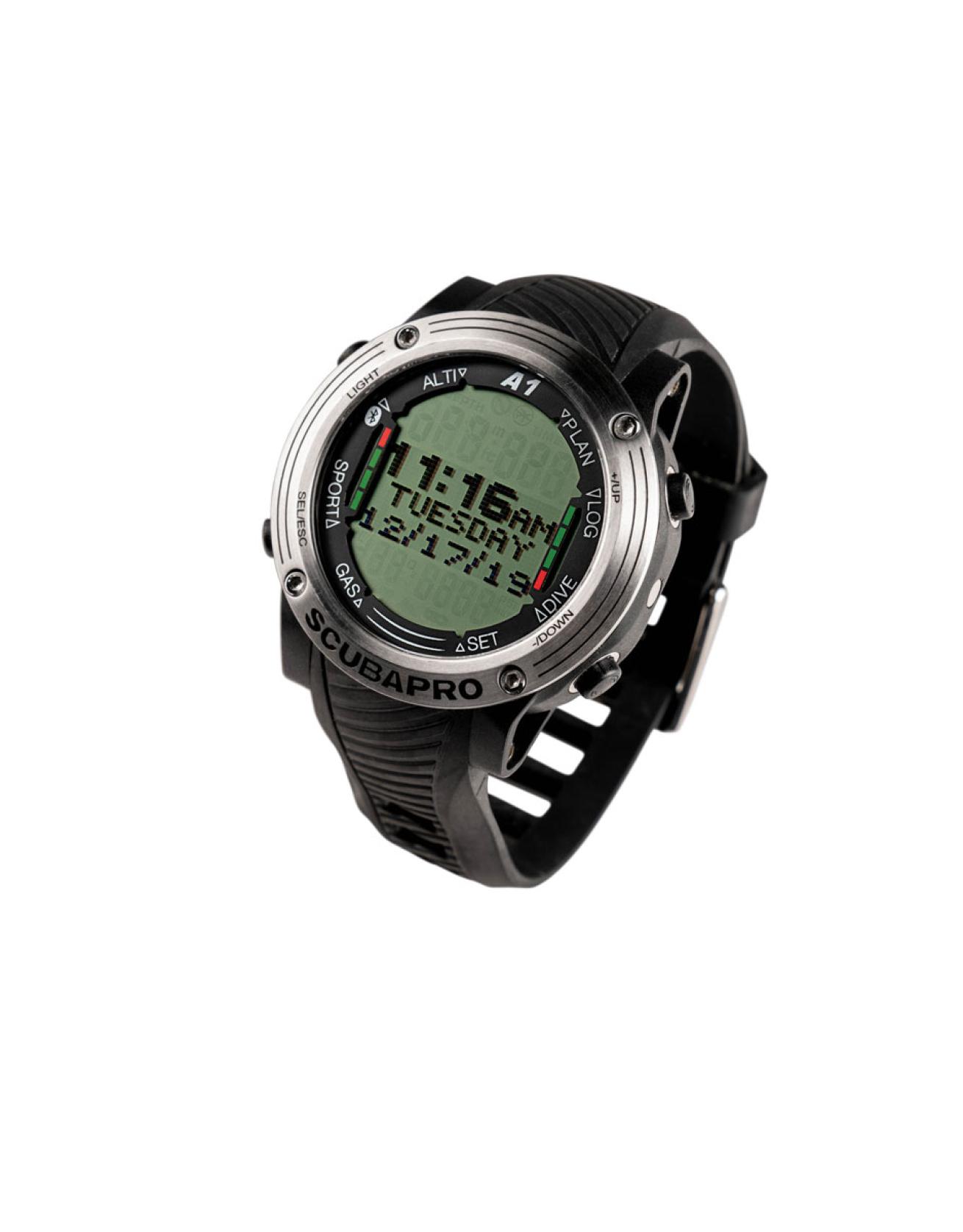
Jon WhittlePRICE $499 | CONTACT scubapro.com
Aimed at entry-level divers, the A1 goes beyond the basics, with features including Bluetooth, adjustable microbubble levels and an altimeter. (The visually similar Aladin A2, priced at $699, has wireless air integration and tec modes). The A1’s operation is relatively simple, with a lower left select/escape button and up/down buttons on the right, along with menu prompts, including a bold “RETURN” that steps it back to the previous page. Watch-size and stylish, the A1 has a screwed-down stainless bezel surrounding a labeled ring that itself circles the 1.15-inch diameter display. While the screen is modest in size, it’s easy enough to read because the matrix characters (especially center-row data) are big and the layout uncluttered and well-marked. “Display basics are presented plainly and clearly,” as one tester said. Critical alerts prompt an insistent beep and display info on a bold reverse-black background, with clear prompts, such as “SLOW DOWN” for rapid ascent; deco depth and time are similarly prominent.
| DOWNLOAD | Bluetooth |
| BATTERY | User-replaceable |
| ALGORITHM | NDLs were about average in our chamber dives. |
Seac Action HR
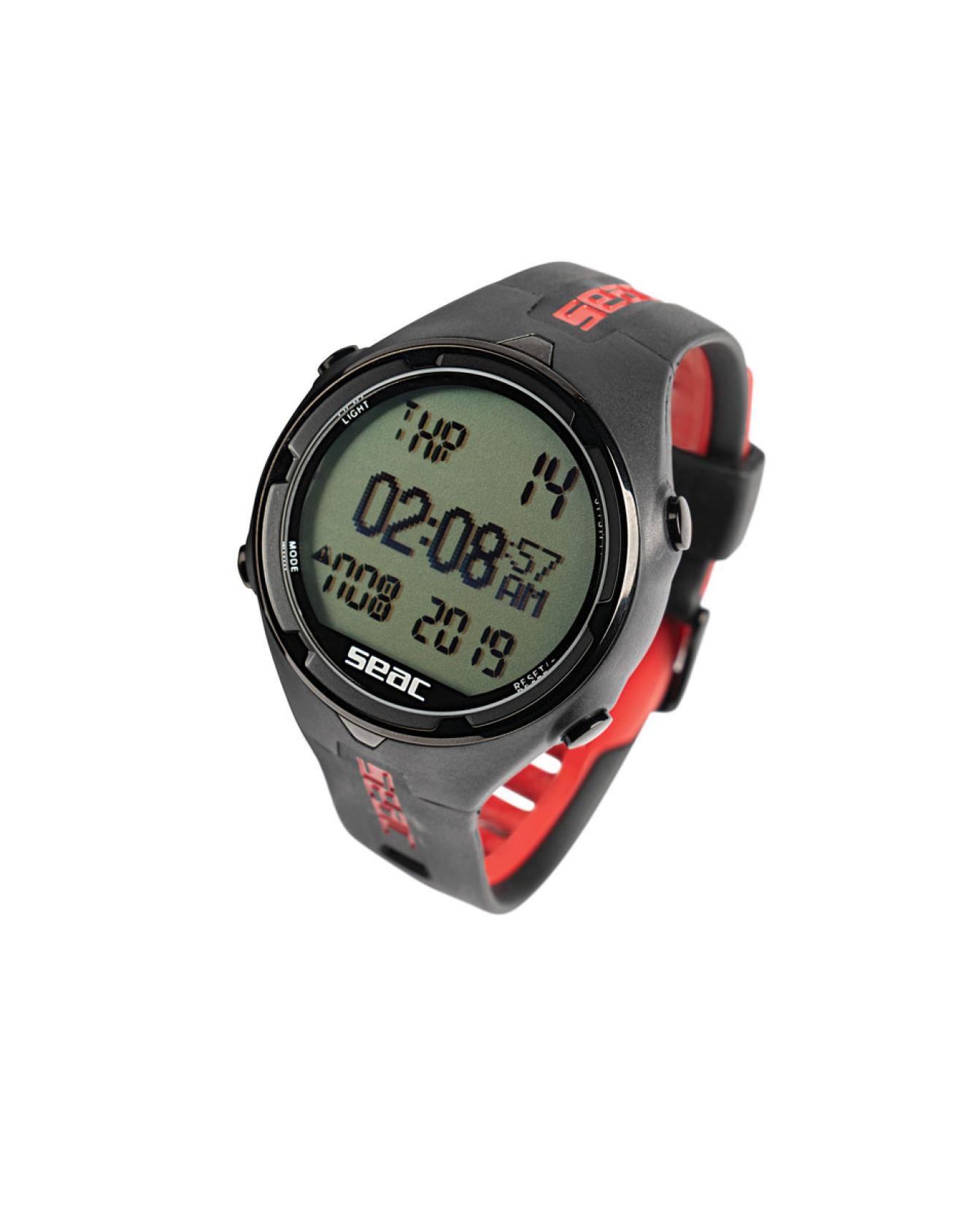
Jon WhittlePRICE $299 | CONTACT seacsub.com
The glossy bezel, buttons and buckle mark this as the HR (high resistance) version of the Action, which is also available with stainless highlights in a standard version. The high contrast 1.3-inch-diameter display was rated very good for readability, with its largest characters (.28 inch tall) displaying depth and NDL, and all data clearly marked with reverse background units that are small but legible.
The dive screen isn’t jammed with data; one button toggles through alternate displays of time, temperature, max depth, average depth and other data. Test divers liked the Action HR’s surface-interval screen, which doesn’t require digging around for relevant data. The computer’s operation, unlike most four-button models we’ve used, doesn’t have a dedicated escape button to back out of menus, instead using a simultaneous press of the two lower buttons for the purpose. That’s effective once you get the operation down pat, but, as one tester noted, “Forget that and you’re lost.” The safety stop, which kicks in at 40 feet, is programmable for both depth and duration, with a minutes-only timer.
| DOWNLOAD | Optional USB cable |
| BATTERY | User-replaceable |
| ALGORITHM | In our chamber dives, it was on the conservative side. |
Console Computers
Sherwood Beacon
Jon WhittlePRICE $1,150 | CONTACT sherwoodscuba.com
Sherwood says this air-integrated console was designed for simple and easy operation. Test divers found no reason to argue with that, awarding the Beacon a tying top score for intuitive operation for its logical three button interface and crystal-clear (if somewhat long) menus in which the active selection is enlarged and highlighted. “Very simple operation, even given the voluminous menu options,” one tester noted. The Beacon’s data display is likewise straightforward, showing the lesser of no-deco time or gas time remaining, which is calculated in real time based on gas consumption. The Beacon’s full-color OLED screen uses its sharply contrasting colors to distinguish and prioritize data for instant, at-a-glance readability. Testers rated it very good for easy reading even at the surface in bright sun, where some color displays seem washed out in the glare. The full-tilt digital compass is basic, but serviceable. With a 1.4-inch-wide screen, the Beacon strikes a nice balance between big enough to see clearly and small enough to rest comfortably in the hand.
| DOWNLOAD | Bluetooth |
| BATTERY | User-replaceable or rechargeable lithium |
| ALGORITHM | It was somewhat liberal in our chamber dives. |
WHAT WE LIKED
Our five favorite features from this year’s computers.
COOL TOUCHES
For example, the Garmin’s elegantly simple no-fly time display.
A BIT OF BUZZ
Underwater it can be hard to distinguish your audible alarm from another diver’s. Haptic feedback removes any doubt.
CUSTOMIZING
Options for screen layout and button shortcuts let you tweak a computer to work better for you.
GOODIES
We don’t want more stuff for its own sake, but whether GPS or exercise apps, we’ll take all the well-done, useful extras you’ve got—as long as they don’t get in the way of it being first and foremost a dive computer.
SIMPLICITY
If computers with all the gadgets can be so easy to operate, why settle for complicated menus and obscure button functions?

